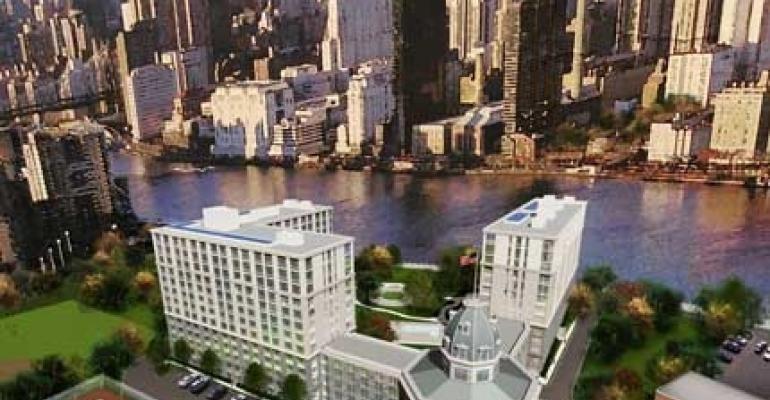New technology, called building information modeling (BIM), is making it easier and cheaper to develop new buildings, especially ones using green, sustainable principles.
BIM software like Autodesk Inc.'s Revit and Graphisoft's ArchiCAD easily links with sustainable design software programs from Green Building Studio and the U.S. Department of Energy, helping architects and developers analyze a building before it's built, says Lachmi Khemlani, Ph.D., founder and editor of AECbytes, a Web site that reviews and rates technology for the building industry. "The analysis is guaranteed to be more effective and easier to do with BIM," she contends.
The ability to link with green building programs is a recent innovation made possible through the rollout of BIM software that addresses structural and mechanical issues in addition to design.
Historically, design and development professionals couldn’t transfer building data without sending blueprints and other papers back and forth. BIM software acts as a repository for all data related to a specific project, integrating all elements of building design and engineering from the floor heights to the weight of the heating, ventilation and air conditioning system.

"Before BIM, developers had no way to accurately predict the long-term cost savings of a green building," says Jay Bhatt, vice president, Autodesk Inc. "They had to go with their gut feeling that building green was better for the environment but they couldn’t really measure the financial impact."
Autodesk is well known for developing AutoCAD, a 3-D design software program that was a precursor to BIM software. The company's Revit BIM software, which includes Revit Building for design professionals, Revit System for mechanical experts, and Revit Structure for structural engineers, ranges in cost $4,995 to $5,395 per copy.
BIM software allows design professionals to create 3-D models of buildings that behave identically to the finished building. They can also explore many iterations of a building design (with different engineering requirements) to maximize performance. The software can also help reduce costs related to material waste and the use of recycled materials.
With BIM software, design and development professionals can get a better handle on the costs of green design techniques and materials, enabling them to make smarter decisions and maximize their profits, says Khemlani. They can sit down at a computer and immediately see how the construction costs and long-term operation costs would change if the building design was modified.
"The software helps with the hundreds of decisions that you need to make to be green," says Bruce Becker, president of New York-based Becker + Becker Associates, which designed and developed Octagon, a 500-unit luxury residential apartment complex on Roosevelt Island in New York City. "It's a very important tool to determine the benefit and cost of each green strategy. With it, you can [add engineering value] to your project."
Octagon is comprised of two towers that boast 250 solar panels, insulated windows and recycled materials. Becker + Becker used ArchiCAD to design and develop the project, winning a coveted "Green Apple" award from the City, which recognizes environmentally friendly buildings.
Similarly, HIP Architects was able to pinpoint the cost of four ambulatory care buildings for Capital Health in Edmonton, Alberta, by using BIM software. As one of the first to use Revit, the firm was able to complete the entire design process for the buildings, which range from 15,000 to 60,000 sq. ft., in less than a year. Partner Allan Partridge says that it would have taken more than 18 months without BIM and the efficiencies created by Revit.
BIM can even gauge the costs of making tiny changes in the design process. For example, Capital Health, the largest health system in Canada, was able to pinpoint the exact costs of the buildings if they were shifted three degrees to deflect sun, or if the amount of glass in the building was decreased. BIM also projected the costs of using a different type of window, too.
Partridge says that Revit allowed the firm to create multiple design plans that had different cost structures without having to redraw every single change in a CAD program. "Previously, we were reticent to explore different design strategies because it would be so time consuming and costly," he says.
Revit shows the consequences of the design changes, Partridge explains, by automatically coordinating changes throughout the design plans. It also has a feature that allows designers to analyze sun positions and solar effects by choosing a specific date and time in the future.
HIP Architect's created the ambulatory centers using sustainable design principles; the buildings use less energy and a significant amount of recycled materials were used in the construction. Using Revit, the firm was able to reduce the amount of glass areas so the smallest HVAC system could be installed. The software also helped identify the most cost effective exterior materials and cut down on construction costs by using panelized wall systems. The buildings cost between $196 per sq. ft. and $223 per sq. ft. — about 12% less than it would have cost without using BIM, according to HIP.
"We got through the design much more efficiently and are confident that the decisions we made were the best ones," Partridge says, adding that he’s seen productivity increase by 30% to 40% since using the software. "BIM has changed the way we're doing architecture because it does all the things that everybody hated doing before."
| Resources | ||||||||||
|

